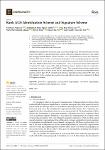Rank AGS Identification Scheme and Signature Scheme
| dc.contributor.author | Nagaraja, V | |
| dc.contributor.author | Ariffin, MRK | |
| dc.contributor.author | Lau, TSC | |
| dc.contributor.author | Adenan, NNH | |
| dc.contributor.author | Chin, Ji-Jian | |
| dc.contributor.author | Yip, S-C | |
| dc.contributor.author | Yap, TTV | |
| dc.date.accessioned | 2023-03-03T10:28:41Z | |
| dc.date.available | 2023-03-03T10:28:41Z | |
| dc.date.issued | 2023-02-24 | |
| dc.identifier.issn | 2227-7390 | |
| dc.identifier.issn | 2227-7390 | |
| dc.identifier.other | 1139 | |
| dc.identifier.uri | http://hdl.handle.net/10026.1/20539 | |
| dc.description.abstract |
<jats:p>The identification protocol is a type of zero-knowledge proof. One party (the prover) needs to prove his identity to another party (the verifier) without revealing the secret key to the verifier. One can apply the Fiat–Shamir transformation to convert an identification scheme into a signature scheme which can be used for achieving security purposes and cryptographic purposes, especially for authentication. In this paper, we recall an identification protocol, namely the RankID scheme, and show that the scheme is incorrect and insecure. Then, we proposed a more natural approach to construct the rank version of the AGS identification protocol and show that our construction overcomes the security flaws in the RankID scheme. Our proposal achieves better results when comparing the public key size, secret key size, and signature size with the existing identification schemes, such as Rank RVDC and Rank CVE schemes. Our proposal also achieves 90%, 50%, and 96% reduction for the signature size, secret key size, and public key size when compared to the Rank CVE signature scheme.</jats:p> | |
| dc.format.extent | 1139-1139 | |
| dc.language | en | |
| dc.language.iso | en | |
| dc.publisher | MDPI AG | |
| dc.subject | public-key cryptography | |
| dc.subject | post-quantum cryptography | |
| dc.subject | code-based cryptography | |
| dc.subject | rank metric | |
| dc.subject | signature scheme | |
| dc.subject | identification scheme | |
| dc.title | Rank AGS Identification Scheme and Signature Scheme | |
| dc.type | journal-article | |
| dc.type | Journal Article | |
| plymouth.author-url | https://www.webofscience.com/api/gateway?GWVersion=2&SrcApp=PARTNER_APP&SrcAuth=LinksAMR&KeyUT=WOS:000948269700001&DestLinkType=FullRecord&DestApp=ALL_WOS&UsrCustomerID=11bb513d99f797142bcfeffcc58ea008 | |
| plymouth.issue | 5 | |
| plymouth.volume | 11 | |
| plymouth.publication-status | Published online | |
| plymouth.journal | Mathematics | |
| dc.identifier.doi | 10.3390/math11051139 | |
| plymouth.organisational-group | /Plymouth | |
| plymouth.organisational-group | /Plymouth/Faculty of Science and Engineering | |
| plymouth.organisational-group | /Plymouth/Faculty of Science and Engineering/School of Engineering, Computing and Mathematics | |
| plymouth.organisational-group | /Plymouth/Users by role | |
| plymouth.organisational-group | /Plymouth/Users by role/Academics | |
| dcterms.dateAccepted | 2023-01-30 | |
| dc.rights.embargodate | 2023-3-4 | |
| dc.identifier.eissn | 2227-7390 | |
| dc.rights.embargoperiod | Not known | |
| rioxxterms.versionofrecord | 10.3390/math11051139 | |
| rioxxterms.licenseref.uri | http://www.rioxx.net/licenses/all-rights-reserved | |
| rioxxterms.type | Journal Article/Review |


